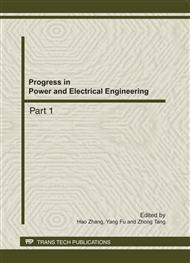[1]
J. A. Miller, C. T. Bowman: Prog Energy & Combust Sci Vol. 15(1989),p.287.
Google Scholar
[2]
T. E. Burch, F. R. Tillman, W. Y. Chen, et al.: Energy Fuels Vol. 5(1991), p.231.
Google Scholar
[3]
B. J. Mereb, J. O. Wendt: Proc. Combust. Inst. Vol. 17(1990), p.1273.
Google Scholar
[4]
Molina, E. C. Eddings, D. W. Pershing, et al.: Prog. Energy Combust. Sci. Vol. 26(2000), p.507.
Google Scholar
[5]
S. C. Hill, L. D. Smoot: Prog. Energy Combust. Sci. Vol. 26(2000), p.417.
Google Scholar
[6]
P. Glarborg, A. D. Jensen, J. E. Johnsson. Prog. Energy Combust. Sci.Vol.29(2003), p.89.
Google Scholar
[7]
V. V. Lissianski, P. M. Maly, V. M. Zamansky: Ind. Eng. Chem. Res. Vol. 40(2001), p.3287.
Google Scholar
[8]
V. V. Lissianski, V. M. Zamansky, P. M. Maly: Combust. Flame Vol.125(2001), p.1118.
Google Scholar
[9]
W.Y. Chen, B. B. Gathitu: Fuel Vol.85(2006), p.1781.
Google Scholar
[10]
Y. Su, B. B. Gathitu, W.Y. Chen: J. Safety Environ. Vol.11(2011), p.65.
Google Scholar
[11]
Y. Su, B. B. Gathitu, W.Y. Chen: Fuel Vol.89(2010), p.2569.
Google Scholar
[12]
Y. Su, B. B. Gathitu, W.Y. Chen: Acta Scientiae Circumstantiae Vol.31(2011), p.1181.
Google Scholar
[13]
R.Guan, W. Li, H.n Chen, et al.: Fuel Proces. Technol. Vol. 85(2004), p.1025.
Google Scholar
[14]
A. Xu, D. Kong, N. Tsubouchi, et al.: The 37th Coal Conference, The Japan Inst. Energy, 2000, p.417.
Google Scholar
[15]
N. Hayhurst, A. D. Lawrence. Combust. Flame Vol. 110(1997), p.351.
Google Scholar
[16]
N. Hayhurst, Y. Ninomiya: Chem. Eng. Sci. Vol.53(1998), p.1481.
Google Scholar
[17]
N. Birks,G. H. Meier: Introduction to high temperature oxidation of metal (Edward Arnold, London, 1983)
Google Scholar
[18]
A. Gradon, J. Lasek: Fuel Vol. 89(2010), p.3505.
Google Scholar
[19]
H. Zhou, J. Lu, H. Zhou, et al.: Acta Scientiae Circumstantiae Vol. 21(2001), p.167.
Google Scholar
[20]
W.Y. Chen, L. Ma: AIChE Journal Vol. 42(1996), p.1968.
Google Scholar
[21]
W.Y. Chen, L.Tang: AIChE Journal Vol. 47(2001), p.2781.
Google Scholar
[22]
Z. Zhao, W. Li, B. Li: Fuel Vol.81(2002), p.1559.
Google Scholar
[23]
P. Glarborg, P. G. Kristensen, K. Dam-Johansen: Energy Fuels Vol. 14(2000), p.828.
Google Scholar
[24]
R. Bilbao, M. U. Alzueta, A. Millera, et al.: Ind. Eng. Chem. Res. Vol. 34(1995), p.4540.
Google Scholar
[25]
P. Kilpinen, P. Glarborg, M. Hupa: Ind. Eng. Chem. Res. Vol. 31(1992), p.1477.
Google Scholar


